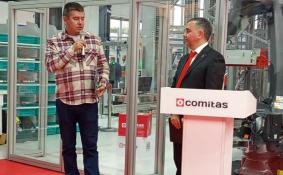Scientific & Practical Journal


Editorial News
Dear readers! We are pleased to present to you the eleventh issue of the journal in 2025. There are a lot of relevant and useful materials in the issue, which, hopefully, will not be ignored.
Dear readers! In September the CeMAT RUSSIA exhibition was held, which showed everyone that innovations and robotics are increasingly penetrating the logistics industry. We can safely say that many technologies are tested here, and only then they go out into the world. However, it is not only CeMAT RUSSIA that demonstrates the prevalence of the digital agenda.
Dear readers! This is the ninth issue of the journal, which turned out to be very rich and diverse. Traditionally, the issue is opened by an analyst. The material by Alina Nasyrova from the Market Guide Agency, dedicated to investments in warehouse complexes in Russia, recalls the importance of developing logistics infrastructure for the integrated development of regions.
PHOTO OF THE WEEK
CITATIONS
Heading:PROBLEMS AND OPINIONS
Formalization of the regulations of transport operations in the logistics system
Leonid Kuznetsov1 / 2016 | PROBLEMS AND OPINIONS
The basis for an effective solution of problems of logistics systems is its formal description which allows the use of the mathematical apparatus of the theory of management. The article described a formal method of the description of the transport structure of the logistics system. Description allows the automatically synthesize a formal model of moving entities in the logistics system.
Key words. Logistic system, formal description, transport structure, moving entities.
The consequences of the introduction of new rules to transport goods for the construction industry
Elena Chernetsova1 / 2016 | PROBLEMS AND OPINIONS
This article reviews a present-day analysis of transportation cost of cement and concrete. In particular, it analyzes influence of recent changes in the law for construction materials market.
Key words. Shipping costs, pricing, concrete.
Optimization of transport and warehouse systems using simulation models (Part 1)
Yuri Tolujev, Tatjana Zmanovskaya1 / 2016 | PROBLEMS AND OPINIONS
The article explains the practical methods for solving of optimization problems in transport and storage systems using their simulation models. The features of transport and storage systems models development and application, and an example of the optimizing the complex suspended monorail conveyor problem solving are described in this article.
Key words. Transport and storage systems, computer simulation, search methods for optimization.
Logistics as a tool pairing of mega-projects: the development of the Eurasian economic Union and economic belt «Silk road»
Oleg Dunaev12 / 2015 | PROBLEMS AND OPINIONS
This article deals with logistics as a means to form a united economic space and provides with the main features of its components. It demonstrates that reorientation of business activity to the Asia Pacific region is to be accompanied by changes in the logistical supply chains, creation of new and more efficient routes for goods delivery, as well as by the definition of interaction points to connect the EAEU and the Silk Road Economic Belt.
The methodological principles of forming regional logistic clusters
Olga Rykalina, Batsaikhan Damdindorj12 / 2015 | PROBLEMS AND OPINIONS
In the article we analyze principles of organization, management and functioning of business entities and various associations. We generalize systematization, classification and additions and propose fundamental principles of formation of regional logistics clusters.
Key words. Organizational-structural, technological, functional, economic, and regulatory principles.
The impact of tariffs on the cost of cargo delivery by different modes of transport
Margarita Nechaeva, Lev Matjushin, Alexander Kuznetsov12 / 2015 | PROBLEMS AND OPINIONS
In the article, the largest in Russia and in the world of automaker Volkswagen, analyzes the market of sales. The calculation of the full cost of delivery of cars of different transportation technologies, with a factory in Kaluga to the regional dealers within the last three years. And recommendations for improving the system of tariffs for the railway, which will increase competition in the industry.
Key words. Road transport, railway transport, shipping, logistics, railway tariff
From M2M to IoT: evolution through synergy
Alexander Tsivlin12 / 2015 | PROBLEMS AND OPINIONS
This article considers current M2M-solution market development stage and its perspectives in Russia and other countries in the World as well as defines technological base for further development. The article offers to consider one of probable means of mutually beneficial cooperation between logistics companies and mobile operators in terms of rapid market penetration of inter-machine communication means and the need to deliver respective technological base.
Key words. Evolution, synergy, M2M, IoT, mobile operators, logistics system, logistics operators.
Logistic support and support the implementation of the environmental resource-saving projects
Andrey Rykalin11 / 2015 | PROBLEMS AND OPINIONS
In this article author tried to unite a few spheres of activities such as ecology, supplement of resources and logistics in terms of logistic support and providing of the implementation environmental resource saving projects. As an example author used the utilization of production waste.
Key words. Environmental projects, resource conservation, reverse logistics chain.
Cross-functional logistical coordination (Part 2)
Vladimir Eskin11 / 2015 | PROBLEMS AND OPINIONS
Cross-functional barriers are the cause of reducing the handling of industrial corporations/enterprises. They reduce the competitiveness of the Russian economy as a whole. Cross-functional logistics coordination is an important element in improving the quality of governance. Holistic approach to the formation of coordination models is caused by the changes in the organizational architecture, business process reengineering, creation of modern information systems, motivation and development of staff.
Cross-functional logistical coordination (Part I)
Vladimir Eskin10 / 2015 | PROBLEMS AND OPINIONS
Cross-functional barriers are the cause of reducing the handling of industrial corporations / enterprises. They reduce the competitiveness of the Russian economy as a whole. Cross-functional logistics coordination is an important element in improving the quality of governance. Holistic approach to the formation of coordination models is caused by the changes in the organizational architecture, business process reengineering, creation of modern information systems, motivation and development of staff.












